Adrienne Astrophotography
3/23/2023
NGC 3293 – Young Cluster
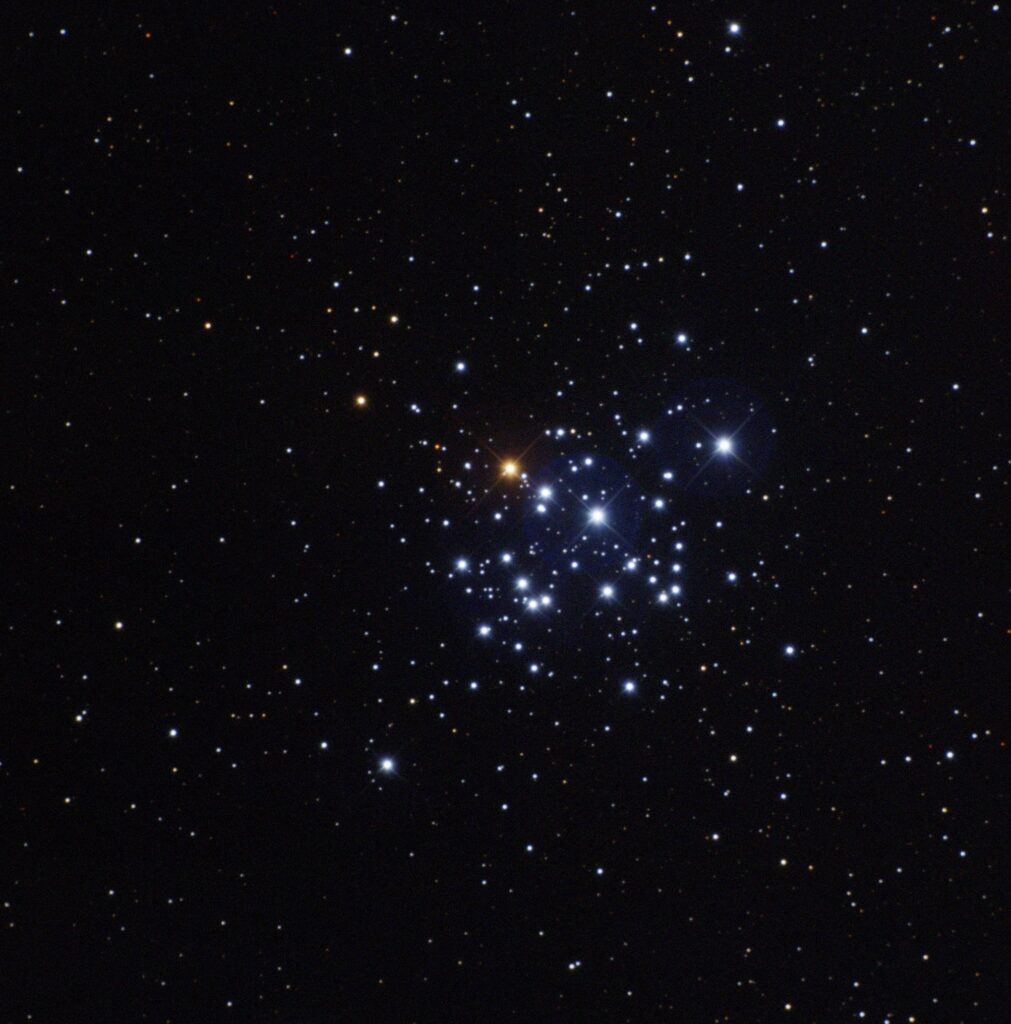
The observation that I used to process this photo was made by my group member, Carlee Markle! The Prompt-6 telescope was used and there were 5 exposures in the B, V, R, and I filter. The total observing time per filter was B ~ 31.5 seconds, V ~ 23.6 seconds, R ~ 11.8 seconds, and I ~ 23.6 seconds. Like my previous posts, in order to process and color balance this image, I first had to align and stack my different color filters, and then combine them all to form one final color image. However, unlike past blog posts, this time I had to account for the reddening that was being caused by intervening dust that is between us and NGC 3293. I found this value via my HR diagram and I ended up going with 0.13 mag, which caused the photo to appear bluer, as it would have been without the dust between us and NGC 3293. Below, are the HR diagrams I made using this photo as a reference!
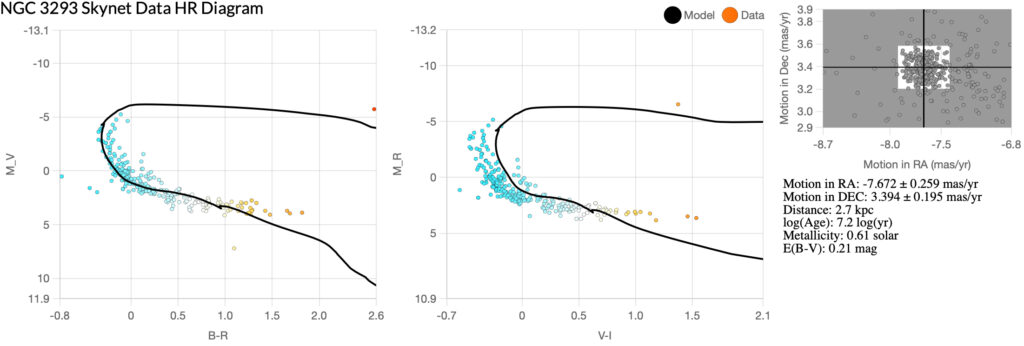
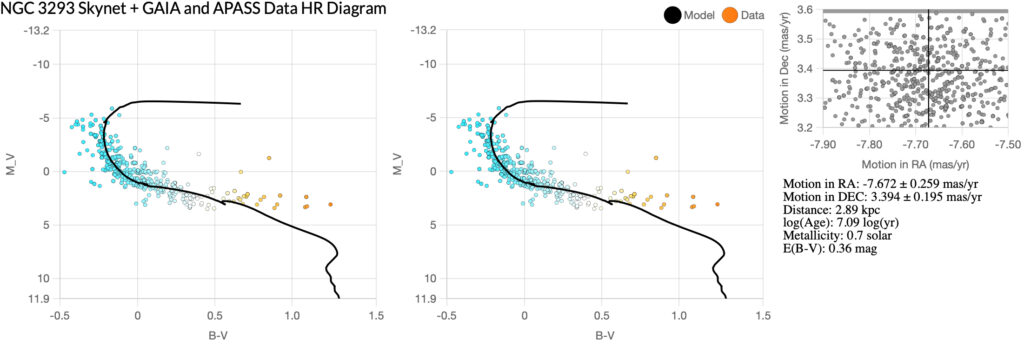
To construct the HR diagrams for NGC 3293, I used a website that plotted the data for me, via a data sheet I downloaded from afterglow! In order to obtain this data sheet, I had to batch photometer each layer of my photo (B, V, R, and I). Although many of the data points included belonged to NGC 3293, there are stars that are between us and NGC 3293, and in order to remove those I cropped them out, as you can see in the rectangle in the image with all of the gray dots. Once I had my first HR diagram with just the data from Skynet, I added archival data from GAIA and 2MASS, which allowed me to narrow down my calculations and get more accurate. Isochrone matching was my favorite part of the HR diagram process! Finding the age by matching the isochrone to the shape of the data was an interesting and interactive component. For the HR diagram with only Skynet data, I found the distance to be 2.7 kpc, the age to be 7.6 log(yr), the metallicity to be 0.61 solar, and the E(B-V) reddening value to be 0.21 mag. For the HR diagram with Skynet, GAIA, and 2MASS data, I found the distance to be 2.7 kpc, the age to be 7.41 log(yr), the metallicity to be 0.62 solar, and the E(B-V) reddening value to be 0.13 mag. Our error bars across my team were very low for all of our values. Our standard deviations for just Skynet data were as follows; for age it was 0.02, for metallicity it was 0.13, and for reddening it was 0.08. Our standard deviations for Skynet, GAIA, and 2MASS data were as follows; for age it was 0.03, for metallicity it was 0.11, and for reddening it was 0.03. As you can see in the above photo of NGC 3293, the majority of the stars in the image are blue, which matches up with the young age I calculated through the HR diagram!
NGC 4349 – Intermediate Cluster
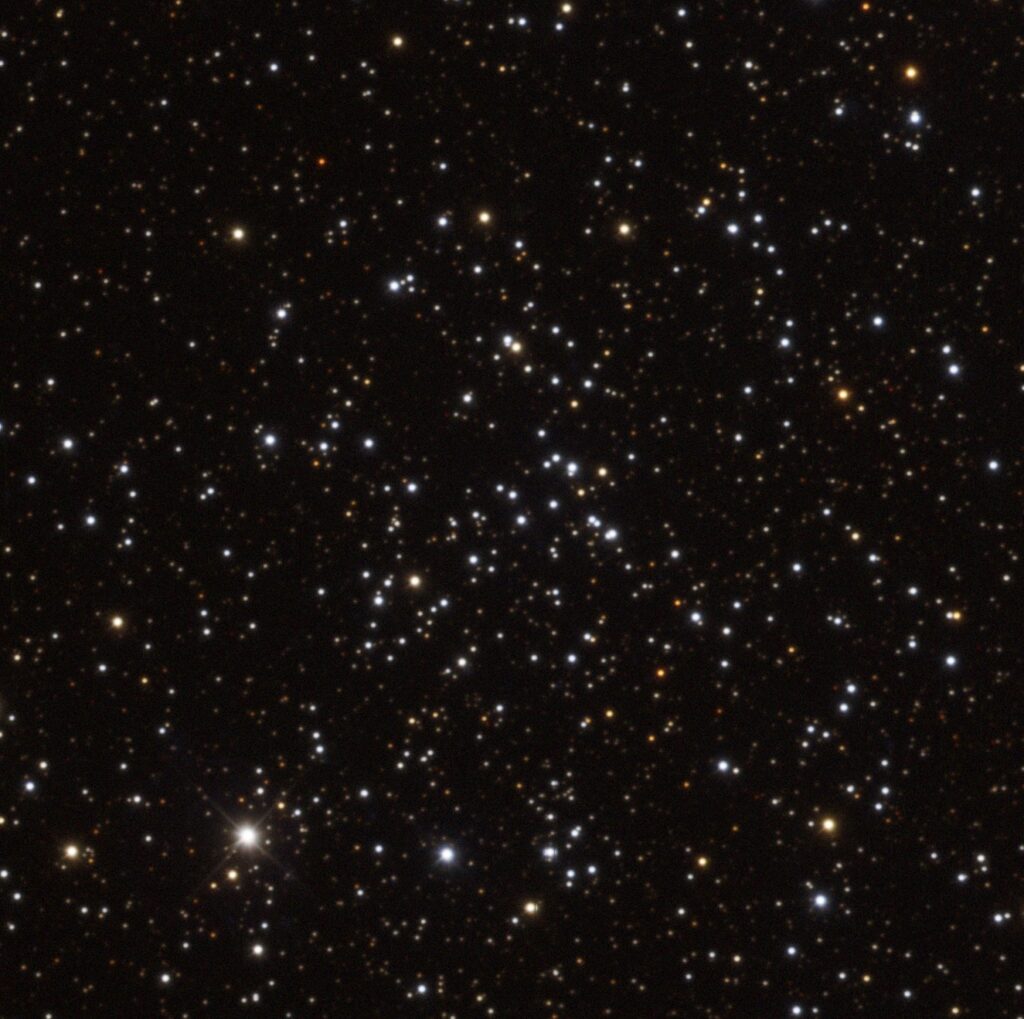
I made the observation that I used to process this photo! The Prompt-6 and Prompt-MO-1 telescopes were used and there were 5 exposures in the B, V, R, and I filter. The total observing time per filter was B ~ 355.86 seconds, V ~ 155.69 seconds, R ~ 88.97 seconds, and I ~ 111.23 seconds. Like my previous posts, in order to process and color balance this image, I first had to align and stack my different color filters, and then combine them all to form one final color image. However, unlike past blog posts, this time I had to account for the reddening that was being caused by intervening dust that is between us and NGC 4349. I found this value via my HR diagram and I ended up going with 0.29 mag, which caused the photo to appear bluer, as it would have been without the dust between us and NGC 4349.
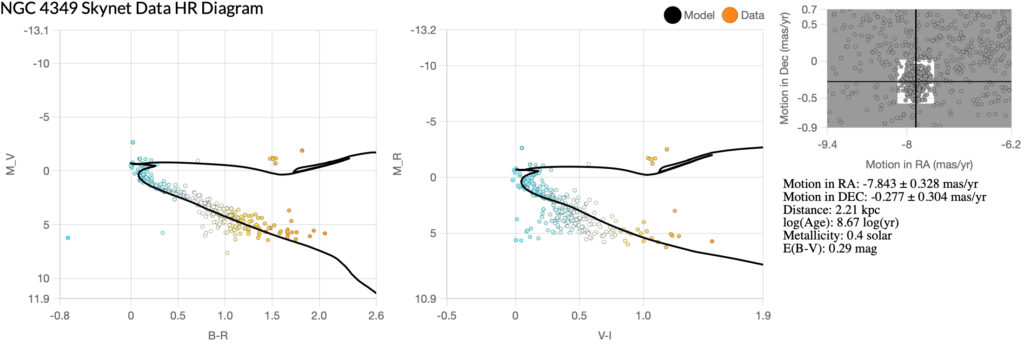
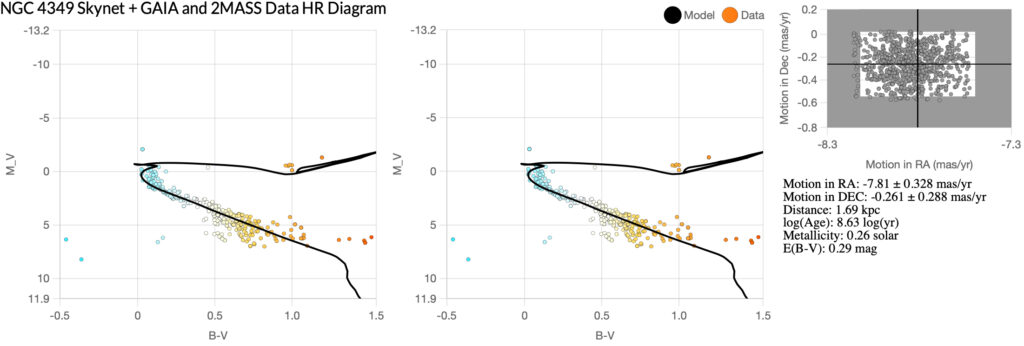
To construct the HR diagrams for NGC 4349, I used a website that plotted the data for me, via a data sheet I downloaded from afterglow! In order to obtain this data sheet, I had to batch photometer each layer of my photo (B, V, R, and I). Although many of the data points included belonged to NGC 4349, there are stars that are between us and NGC 4349, and in order to remove those I cropped them out, as you can see in the rectangle in the image with all of the gray dots. Once I had my first HR diagram with just the data from Skynet, I added archival data from GAIA and 2MASS, which allowed me to narrow down my calculations and get more accurate. Isochrone matching was my favorite part of the HR diagram process! Finding the age by matching the isochrone to the shape of the data was an interesting and interactive component. For the HR diagram with only Skynet data, I found the distance to be 2.21 kpc, the age to be 8.67 log(yr), the metallicity to be 0.4 solar, and the E(B-V) reddening value to be 0.29 mag. For the HR diagram with Skynet, GAIA, and 2MASS data, I found the distance to be 1.69 kpc, the age to be 8.63 log(yr), the metallicity to be 0.26 solar, and the E(B-V) reddening value to be 0.29 mag. Our error bars across my team were very low for all of our values. Our standard deviations for just Skynet data were as follows; for age it was 0.16, for metallicity it was 0.64, and for reddening it was 0.11. Our standard deviations for Skynet, GAIA, and 2MASS data were as follows; for age it was 0.10, for metallicity it was 0.78, and for reddening it was 0.17. In the above photo of NGC 4349, you can see many different shades of red and blue, which matches up with the intermediate age that I calculated with the HR diagram!
NGC 3201 – Old Cluster
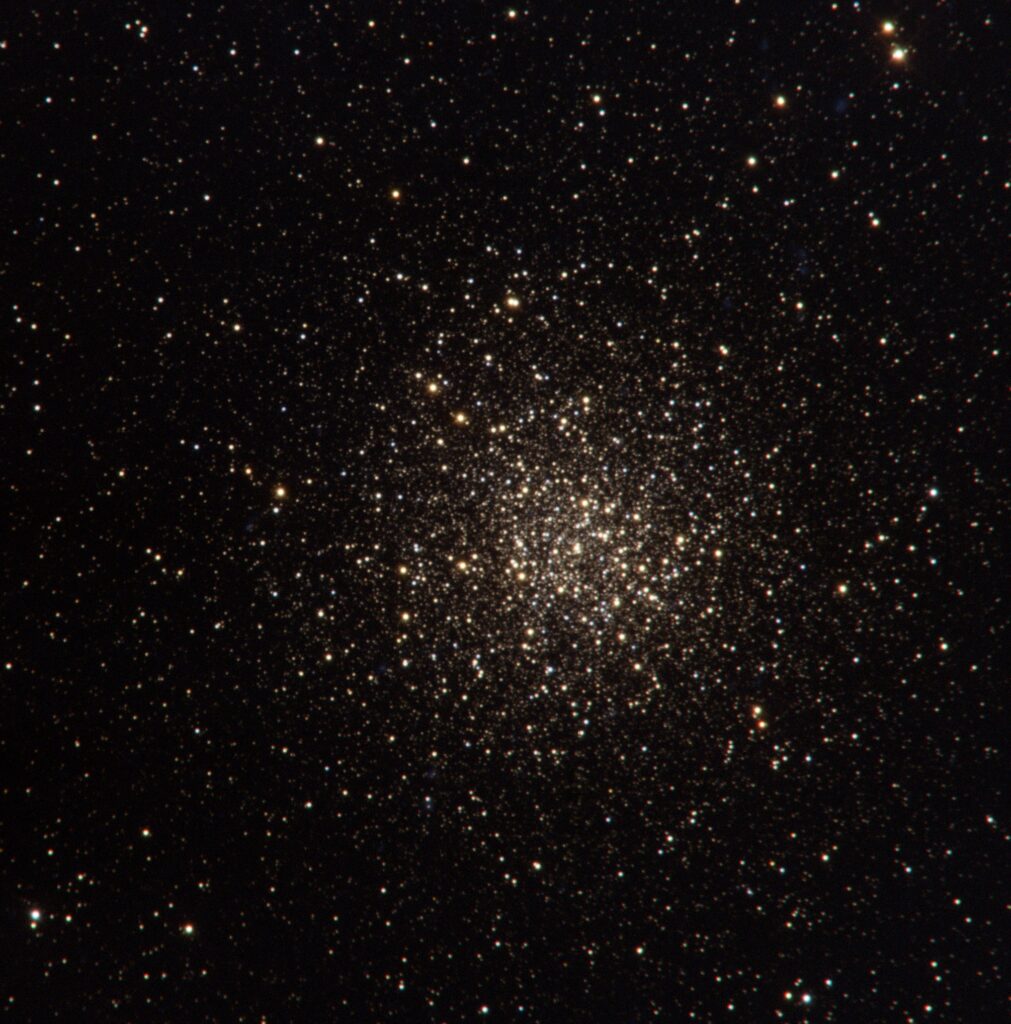
(also linked in my bio!)
Instagram: @adrienne.astrophotography
My group member, Margaret Wright made the observation that I used to process this photo! The Prompt-6 telescope was used and there were 5 exposures in the B, V, R, and I filter. The total observing time per filter was B ~ 354.35 seconds, V ~ 295.3 seconds, R ~ 263.2 seconds, and I ~ 118.1 seconds. Like my previous posts, in order to process and color balance this image, I first had to align and stack my different color filters, and then combine them all to form one final color image. However, unlike past blog posts, this time I had to account for the reddening that was being caused by intervening dust that is between us and NGC 3201. I found this value via my HR diagram and I ended up going with 0.29 mag, which caused the photo to appear bluer, as it would have been without the dust between us and NGC 3201.
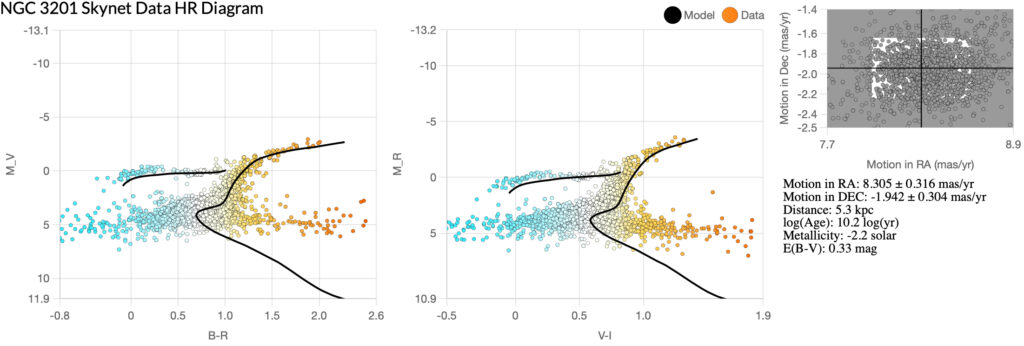
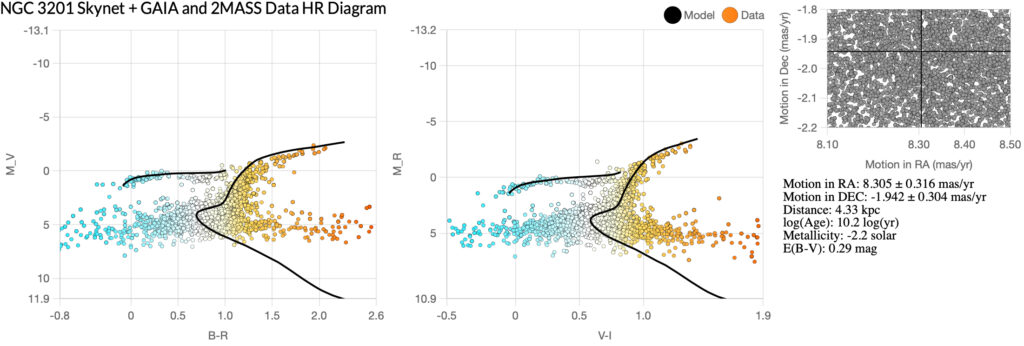
To construct the HR diagrams for NGC 3201, I used a website that plotted the data for me, via a data sheet I downloaded from afterglow! In order to obtain this data sheet, I had to batch photometer each layer of my photo (B, V, R, and I). Although many of the data points included belonged to NGC 3201, there are stars that are between us and NGC 3201, and in order to remove those I cropped them out, as you can see in the rectangle in the image with all of the gray dots. Once I had my first HR diagram with just the data from Skynet, I added archival data from GAIA and 2MASS, which allowed me to narrow down my calculations and get more accurate. Isochrone matching was my favorite part of the HR diagram process! Finding the age by matching the isochrone to the shape of the data was an interesting and interactive component. For the HR diagram with only Skynet data, I found the distance to be 5.3 kpc, the age to be 10.2 log(yr), the metallicity to be -2.2 solar, and the E(B-V) reddening value to be 0.33 mag. For the HR diagram with Skynet, GAIA, and 2MASS data, I found the distance to be 4.33 kpc, the age to be 10.2 log(yr), the metallicity to be -2.2 solar, and the E(B-V) reddening value to be 0.29 mag. Our error bars across my team were very low for all of our values. Our standard deviations for just Skynet data were as follows; for age it was 0.41, for metallicity it was 0.13, and for reddening it was 0.17. Our standard deviations for Skynet, GAIA, and 2MASS data were as follows; for age it was 0.09, for metallicity it was 0.23, and for reddening it was 0.04. As you can see in the above photo of NGC 3201 and the golden, reddish color of the stars, it matches up with the older age that I calculated via the HR diagram!